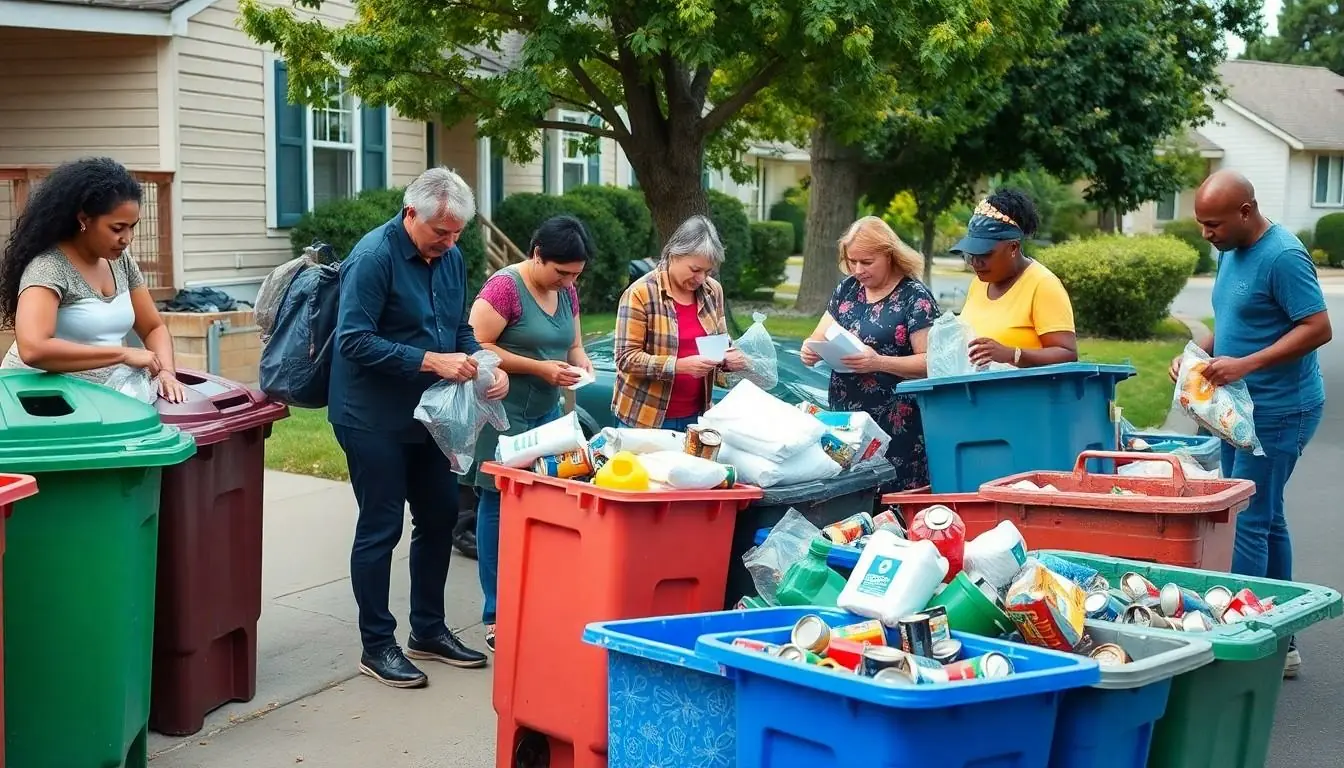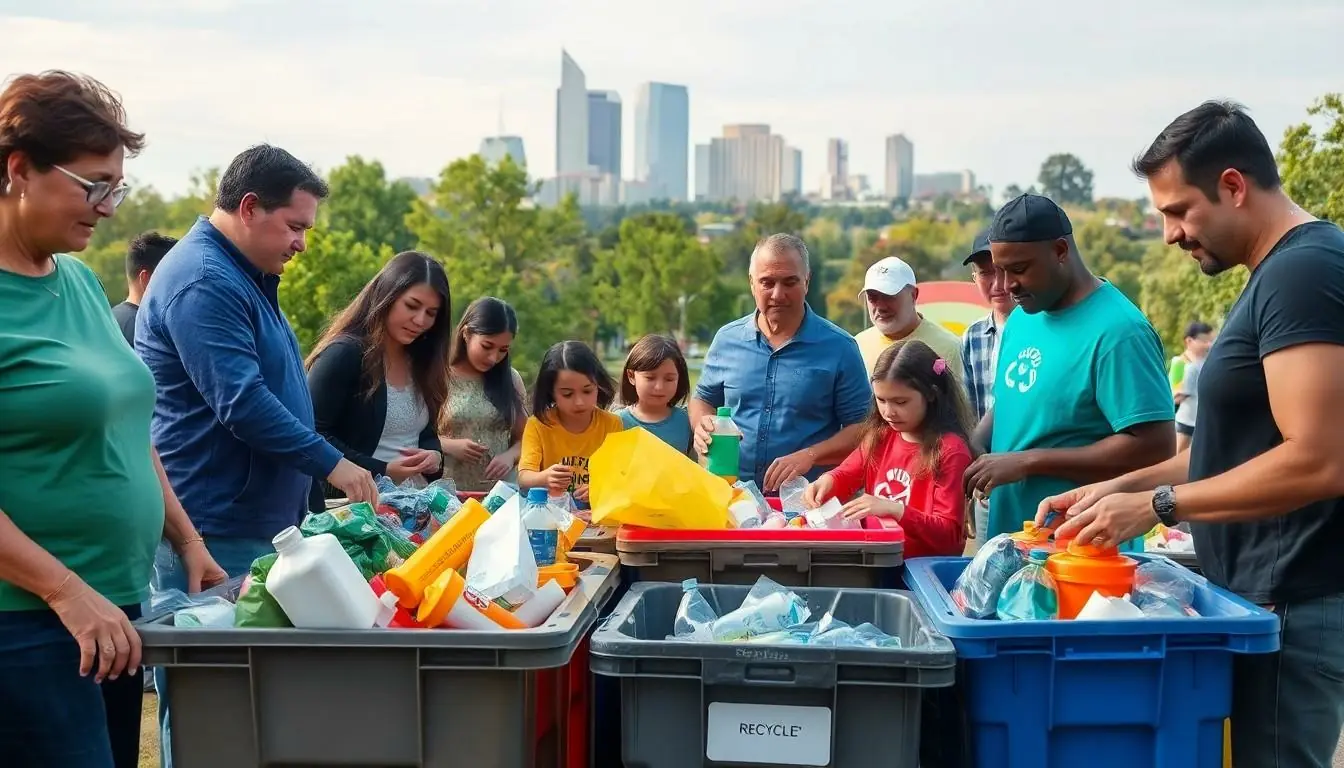In the heart of California, Sacramento isn’t just known for its vibrant culture and stunning parks; it’s also making waves in the recycling world. With a mission to reduce waste and promote sustainability, the city is turning trash into treasure—one bottle at a time. Who knew that sorting your recyclables could be so rewarding?
Table of Contents
ToggleOverview of Sacramento Recycling
Sacramento’s recycling program focuses on reducing landfill waste and promoting sustainability. The city’s initiatives aim to improve recycling rates, targeting a 75% diversion goal by 2025. Residents can participate through curbside recycling, drop-off locations, and special event collections.
Materials accepted include paper, cardboard, plastics, metals, and glass. Contaminants like food waste and plastic bags hinder recycling efforts, leading to increased costs and reduced efficiency. Educating the community on proper sorting and disposal practices remains crucial for success.
Organizing events like the annual Recycling Day encourages participation. Local schools in Sacramento incorporate recycling education into their curricula. Businesses also play a pivotal role in this initiative by adopting sustainable practices, benefiting both the environment and their bottom line.
Sacramento’s commitment to recycling extends beyond residential efforts. The city collaborates with nonprofits and local organizations to enhance outreach and awareness. Incentives for businesses adopting green practices help shift the culture towards sustainability. Engaging residents in various programs fosters a sense of community responsibility.
Efforts to track and report recycling data are essential for ongoing improvement. Achieving transparency in these metrics allows the city to identify challenges and celebrate successes. Continuous innovation in recycling technologies and methods supports Sacramento’s vision of a sustainable future.
Types of Materials Recycled in Sacramento

Sacramento’s recycling program accepts a variety of materials, ensuring effective waste diversion and resource recovery. Understanding what can be recycled helps residents participate actively.
Curbside Recycling Program
The curbside recycling program allows residents to sort and place materials for easy collection. Accepted items include paper products such as newspapers and magazines, along with cardboard boxes. Containers made of plastics numbered 1 through 7 can also be recycled, alongside metals like aluminum and steel cans. Glass bottles and jars round out the list of curbside recyclables. The program emphasizes proper sorting to minimize contamination, which can hinder the recycling process.
Drop-off Recycling Centers
Drop-off recycling centers provide an additional outlet for residents to recycle materials. These centers accept a broader range of items, including electronic waste, batteries, and textiles. Residents can bring items that may not fit in curbside bins, ensuring responsible disposal. Locations throughout Sacramento offer convenience for individuals seeking to recycle larger quantities or specialized materials. Educational signage at these centers guides residents on proper disposal methods, further enhancing the city’s recycling efforts.
Benefits of Recycling in Sacramento
Recycling in Sacramento offers a multitude of benefits that enhance community well-being and environmental health.
Environmental Impact
Recycling significantly reduces the amount of waste sent to landfills. According to the city, more than 1.1 million tons of waste are diverted each year through its recycling programs. This decreases greenhouse gas emissions by lessening the need for new materials, which often rely on energy-intensive processes. Additionally, recycling conserves natural resources like timber, water, and minerals. By staying engaged, residents can contribute to protecting local ecosystems and supporting biodiversity, ensuring that Sacramento remains a vibrant and healthy environment for future generations.
Economic Advantages
Economic benefits accompany Sacramento’s recycling initiatives, leading to job creation and cost savings. The city’s recycling programs support over 1,200 jobs in the recycling and waste management sectors. Increased participation in recycling can decrease disposal costs for infrastructure maintenance and lower future landfill fees for residents. Furthermore, recycling generates revenue through the sale of recovered materials. The growth of local businesses that focus on reusable products strengthens the economy, fostering a culture of sustainability that benefits everyone in Sacramento.
Challenges Facing Sacramento Recycling
Sacramento faces several challenges in its recycling efforts. Contamination remains a significant obstacle for the city, impacting overall recycling efficacy.
Contamination Issues
Contaminants negatively affect recycling outcomes. Items such as food waste, plastic bags, and non-recyclable materials often end up in recycling bins, leading to contaminated loads. When this occurs, entire batches of recyclables can be rejected. Education on proper sorting is crucial for residents. Misunderstanding what can and cannot be recycled complicates the process and increases contamination rates.
Public Awareness and Participation
Public awareness plays a critical role in the success of Sacramento’s recycling initiatives. Many residents may lack knowledge about the city’s recycling policies and accepted materials. Participation can improve through targeted campaigns and community outreach. Programs in schools, along with events like Recycling Day, aim to engage residents and enhance understanding. Increased awareness leads to better involvement, ultimately boosting the city’s recycling rates and achieving its 75% diversion goal by 2025.
Future of Recycling in Sacramento
Sacramento’s commitment to recycling evolves with ambitious plans to enhance sustainability and resource management. The city’s future focuses on innovative initiatives aligned with the goal of achieving a 75% diversion rate by 2025.
Upcoming Initiatives
New programs aim to improve recycling efficiency and expand the range of accepted materials. Implementing advanced sorting technologies will reduce contamination and increase recovery rates for paper, plastics, metals, and glass. The city plans to introduce a composting initiative, allowing residents to recycle organic waste. Additionally, partnerships with local businesses will promote the use of reusable products, further encouraging sustainable practices. Educational campaigns will inform residents about these changes and how to participate effectively.
Community Engagement Efforts
Community participation remains essential to Sacramento’s recycling success. Neighborhood workshops will provide hands-on training about proper sorting techniques and the importance of recycling. Schools are set to receive resources that incorporate recycling education into their curriculums, fostering awareness among younger generations. Events like Recycling Day will continue, inviting families to learn about waste reduction in engaging ways. Social media campaigns will broaden the reach, ensuring critical information is accessible to all residents. Community involvement will drive momentum toward Sacramento’s sustainability goals, bringing collective efforts to the forefront of local environmental stewardship.
Sacramento’s commitment to recycling and sustainability is paving the way for a greener future. With a robust recycling program and community involvement, the city is making significant progress towards its 75% diversion goal by 2025. Education and awareness are crucial in reducing contamination and enhancing participation among residents.
As Sacramento continues to innovate in recycling technologies and expand its initiatives, the collaboration between the city, businesses, and nonprofits will play a vital role in fostering a culture of sustainability. By embracing these efforts, residents can contribute to protecting the environment while enjoying the benefits of a cleaner and more sustainable community. Together, they are not just recycling materials but are also nurturing a healthier planet for future generations.





